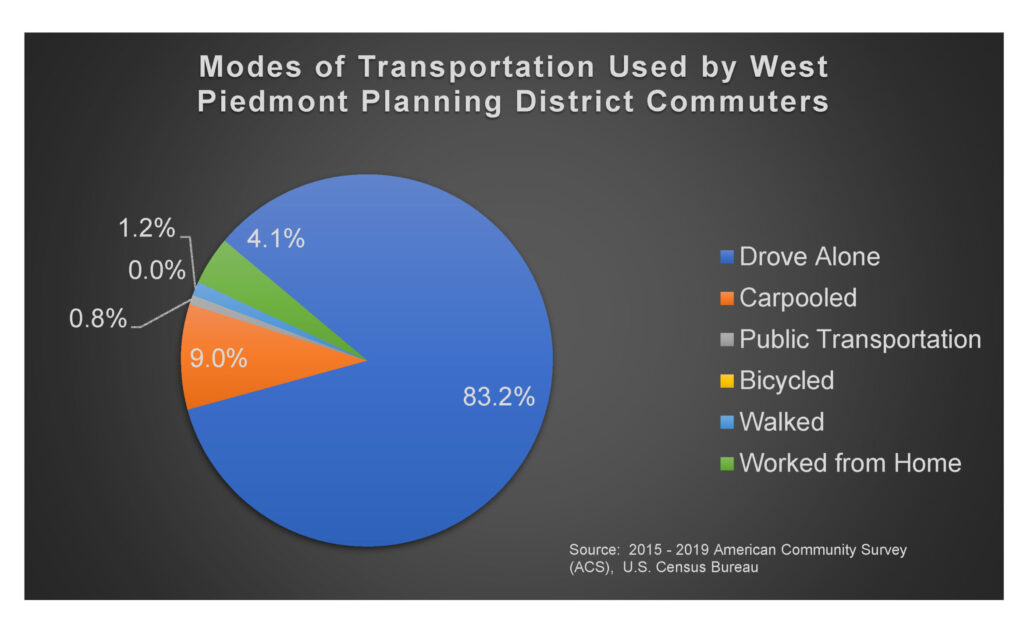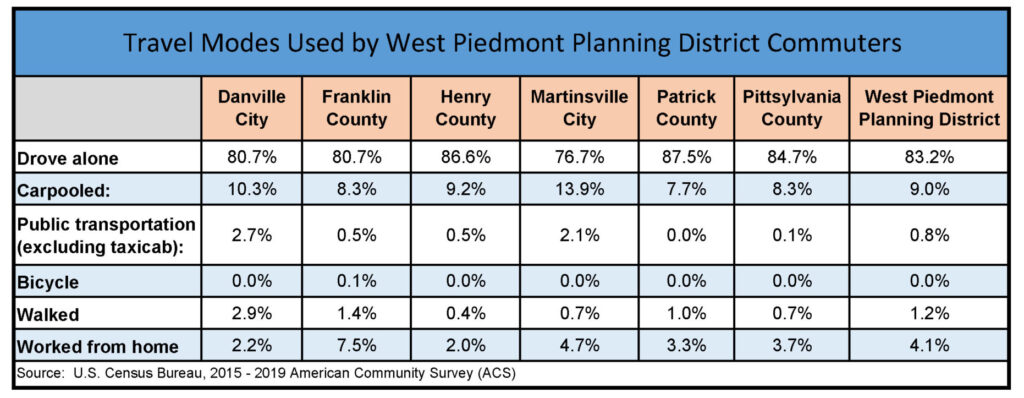On December 10th, the U.S. Census Bureau released results of its 2015 – 2019 American Community Survey (ACS), and “Means of Transportation to Work” is one of many sets of data that were released. Americans are most familiar with the decennial census, which consists of a full population and housing count in the U.S. taken during the first year of every decade. Unlike the decennial census, the ACS is released on an annual basis and is based upon estimates rather than full counts. The ACS comprises two sets of data, a one-year set of data and a five-year set. The analysis within this blog utilizes the five-year set of data (2015 – 2019), as it is believed this may be most accurate due to an average of the data over several years, particularly since the ACS relies on sample data.
Based on the figure below, 83.2% of the region’s commuters drove alone to work, which would be expected for a region which is generally of rural character. The figure also shows that 9% of the region’s workers carpooled, 0.8% used public transportation, 1.2% walked to work, and 4.1% worked from home.

The Following table, entitled “Travel Modes Used by West Piedmont Planning District Commuters,” summarizes the travel mode share utilized by commuters residing with the West Piedmont Planning District, based on the 2015 – 2019 ACS. Not surprisingly, the shares of commuters that drove alone to work were lowest in localities served by public transportation, notably the cities of Danville and Martinsville. What is surprising is that both cities also exhibited the highest shares of workers who carpooled in the region, with Danville’s and Martinsville’s residents accounting for 10.3% and 13.9%, respectively. One might suspect that the counties, which tend to be characterized by more dispersed settlement patterns, would exhibit higher shares of carpooling, as residents may desire to save money and wear-and-tear on their vehicles, given that their commutes would likely be of a longer distance in general. The table also shows that the City of Danville represented the highest share among localities in which residents walked to work. This is no surprise, given the city’s compact development pattern. The relatively low share of residents who walked to work in Martinsville, however, was very interesting, given that the city’s development pattern is also very compact. Franklin County exhibited the highest share of individuals who worked at home (7.5%), and given that County’s proximity to Roanoke with its professional sector employment, this is no surprise.

The data presented herein encompasses the years 2015 to 2019, and therefore does not caputure the changes imposed on our society by the COVID-19 pandemic. It is likely that, had such information encompassed the past eight or nine months, the share of workers carpooling and even driving alone would have exhibited a reduction, while the share of workers teleworking, or working from home, would have exhibited a dramatic increase. It is also likely that public transit usage declined since the onset of the pandemic, as well.
If you are interested in or are currently commuting via any of modes discussed in this blog, with the exception of driving alone, you can earn points toward rewards every time you log a trip using the free RIDE Solutions app. Simply visit ridesolutions.org to get started! If you are an employer considering the implementation of a commuter assistance program for your employees, please contact me, Joe Bonanno, at either Jbonanno@wppdc.org or (276) 638-3987!


